Prince Albert, AB to Hudson Bay, AB |
| Saskatchewan - "Land of living skies." A beautiful cloud street - paragliding heaven! |
7-27-01 Chelsie looked up at me with large brown eyes, a huge smile and blonde hair pulled back into short pigtails. She was full of questions about my trip. By the end of the conversation she mentioned that she hoped to one day ride her horse across Canada. I thought about it for a moment and wasn't sure how a horse could take the roads with the trucks rushing past and the deep gravel or hard pavement.
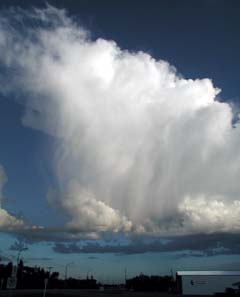 |
| Virga - rain that evaporates before reaching the ground |
Perhaps sensing my logistic gymnastics, she quickly commented that her horse wasn't in good enough shape to do it anyway and she'd probably only make it to Calgary. This comment was one that was easy to provide hope and encouragement - horses, like people, I'm sure would grow accustomed to the exercise as long as the beginning pace was slow, easy and gradual. She left with her family, her head full of dreams I hope she fulfills one day. Biking away from the little rest stop, I realized that by the time she is old enough to start such a trip the trans-Canada trial would be completed, providing exactly the terrain she would need for her horse - free of trucks, and crossing many rivers without steep barriers. Her trip would be very possible. I wished I had not spent the moment to contemplate logistics while with Chelsie and my heart jumped with each young horse rider I saw, wondering if I should try to pass the message through another girl in the area - her trip would be very possible on the trans-Canada trail in a few years!
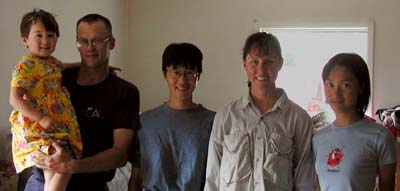
7-28-01 A white truck pulled off the road in the distance. I watched the truck as I approached, as this is often a signal that the person in the car wants to talk to me. A man got out of the car and went to the other side, bringing out a little girl. He then walked to the road side of the car and stood waiting for me to reach him. He had toured on his bike in the past and wanted to offer his place to stay that night. He and his wife had an exchange student arriving that evening, but as they had two guest rooms there should be plenty of room. Since he lived far from the main road he gave me his phone number and told me to call when I was finished for the day and he'd pick me up and bring me to his place. The drive to the farm at the end of the day was very interesting.
 |
| Alfalfa seed fields with tents for leaf cutter bees to pollinate the crops |
He is a great teacher, having done many different professions before farming, he was interested in the workings and background of farming and the surrounding area and with enthusiasm taught me about the crops that are growing in the area. Since American farmers are subsidized by the government, Canadian farmers are unable to make a living selling the usual crops of barley, wheat and beans.
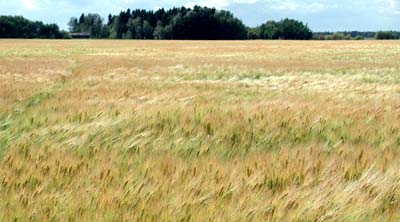 |
| Wheat field - most wheat is sent overseas, as US markets are subsidized |
However these are the plants that they are used to growing in this area. I learned that some farmers now are planting both beans and barley in their fields to feed the cows (a much better market.) Grown together these plants fertilize the soil (beans are nitrogen fixing plants) while also making a nutritious and tasty feed for the cows. A delicious Japanese dinner was waiting for me when we arrived.
7-29-01 Greg's wife, Junko (pronounced June-koe), is the only certified Japanese-English translator in Saskatchewan, but living out in the middle of the vast farm fields of Saskatchewan it is difficult for people to find her. She and Greg had been wanting to make a website so that people could find them, but didn't know quite where to start to learn HTML. That morning Junko and the exchange student had to regroup the cows, as the wind had knocked down one of the fences during the night
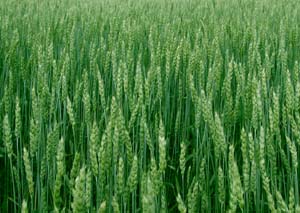 |
| Barley field - crops sent to US to make beer and fed to local cows |
and they were happily munching away on fresh fields that weren't ready for them yet. Greg and I sat down at the computer, originally to check the weather for the day, and I gave him a one hour class on basic HTML. Soon he had a picture of one of his little girls on a page surrounded by bits of words, tables and links - all the basic parts of a webpage. Hopefully soon they'll have a web page posted for Junko's translation services. Driving back to the main road for me to continue, he continued my farming lessons, teaching me about canary seed fields - a profitable crop for the pets of the US, and alfalfa seed fields with their little tents for leaf cutter bees to fertilize this important crop for the US and Europe's fields (alfalfa fixes nitrogen for the soil and is used in the US and Europe as a rotation crop to revitalize the soil before replanting corn and other crops in the same area. I had never thought about where the seed for these "fallow" fields came from. One more crop of interest for me were the Canola fields. Canola is closely related to mustard, and I had been sure that I was seeing mustard fields. So the pictures of the vast yellow rolling hills from a few pages back were Canola, not mustard.
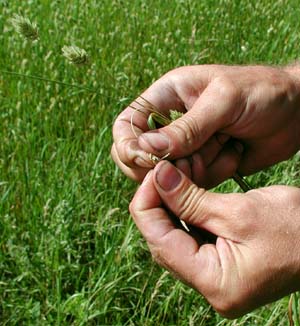 |
| Canary Seed - crops sold to US pet supply markets |
My newly fixed trailer tire was causing problems again. The thumping of the tire was soon so exaggerated that I was worried my computer would be damaged. Reminding myself that it is best to stop and give the problem some attention I pulled off at the nearest post and hesitantly walked to the back of the trailer. The problem was obvious upon looking at the wheel. The place where the glass had cut into the tire had become a hole through which the inner tube was protruding. I released pressure from the wheel and this smoothed out most of the unevenness. Also the fender had lost a bolt and was rubbing against the wheel. I removed the fender completely and strapped it onto my bag. With a smile I pulled back onto the road, hoping my temporary fix would hold until the next town - Hudson Bay.










 7-28-01 A white truck pulled off the road in the distance. I watched the truck as I approached, as this is often a signal that the person in the car wants to talk to me. A man got out of the car and went to the other side, bringing out a little girl. He then walked to the road side of the car and stood waiting for me to reach him. He had toured on his bike in the past and wanted to offer his place to stay that night. He and his wife had an exchange student arriving that evening, but as they had two guest rooms there should be plenty of room. Since he lived far from the main road he gave me his phone number and told me to call when I was finished for the day and he'd pick me up and bring me to his place. The drive to the farm at the end of the day was very interesting.
7-28-01 A white truck pulled off the road in the distance. I watched the truck as I approached, as this is often a signal that the person in the car wants to talk to me. A man got out of the car and went to the other side, bringing out a little girl. He then walked to the road side of the car and stood waiting for me to reach him. He had toured on his bike in the past and wanted to offer his place to stay that night. He and his wife had an exchange student arriving that evening, but as they had two guest rooms there should be plenty of room. Since he lived far from the main road he gave me his phone number and told me to call when I was finished for the day and he'd pick me up and bring me to his place. The drive to the farm at the end of the day was very interesting. 




